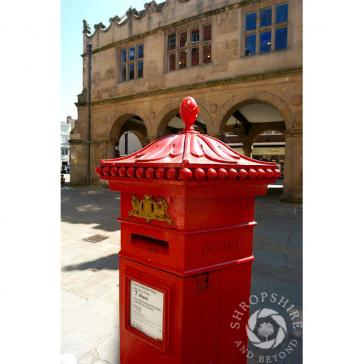Description
The Penfold postbox was designed by John Wornham Penfold, who was born 190 years ago. He has now received accreditation for this design the Royal Institution of Chartered Surveyors. Built with Readymag—a tool to design anything on the web.
Framed original miniature gouache watercolour detailed painting of a Penfold post box by a tree. Signed in the lower left corner by the artist, Ken Taylor.
Ken Taylor was born in 1939, in Liverpool. Educated at Holt High School. He trained as a graphic designer and worked in advertising agencies in Liverpool until 1977.
After 20 years of the hectic advertising lifestyle, he and his wife, Jean and three children opted for better quality of life and moved to a small village on the Wales/Shropshire border, near Oswestry. Here he began to paint and was encouraged by other professional artists to specialise in miniature paintings. Ken is entirely self-taught and paints on a black mount board with gouache (an opaque watercolour). Most inspiration comes from the seasonal changes along country lanes around his home.
Ken Taylor’s work has been sold worldwide and has many collectors. He has exhibited and sold many pieces of work at several exhibitions including the Hilliard Society of Miniaturists and the Royal Academy, London.

If you are interested in this miniature Penfold post box painting or other artwork from Ken Taylor, please contact us.
+44 (0)1244 342 520 / 07785 580786
info@baronfineart.co.uk
This year marks the death centenary of John Wornham Penfold, designer of probably Britain’s best loved pillar box. Penfold was born in Haslemere, Surrey on 3rd December 1828. He studied architecture and surveying, and was employed first by Charles Lee, before starting his own business.

Penfold rose to the top of his profession serving as President of the Architectural Association and becoming an Associate of the Royal Institute of British Architects. He was also a founder member of the Institute of Surveyors, serving as its first Honourary Secretary (the Institute was later granted a Royal Charter, making it the Royal Institution of Charted Surveyors).
In 1880 Penfold was appointed as a surveyor to the Worshipful Company of Goldsmiths and re-designed the Jewin Street area in the City of London after it had been destroyed by a large fire (this area was again destroyed by bombs during World War 2 and is now the site of the Golden Lane Estate).
One of Penfold’s finest works was at the former Naval Training School in New Cross, South London. In 1890 the site was taken over by the Goldsmiths Company and was converted into a technical and recreational institute. Penfold modified the building to suit its new propose and enclosed the central courtyard to create a Great Hall. This site is now part of Goldsmiths, University of London.
Throughout his life Penfold regularly returned to his native Haslemere. He surveyed the local area when the railways came, rebuilt and expanded Haslemere parish church and surrounds, and designed other local buildings. But Penfold is best remembered for his work for the Post Office.
In 1866 Penfold submitted designs for a pillar box. The Post Office had been attempting to standardise letter boxes throughout the country for some time, and had produced a national standard, but this was found to be wanting. With Penfold’s box the Post Office again attempted to establish an enduring national standard.
A replica Penfold pillar box in the collection of the BPMA
Penfold’s box – or the Penfold, as it became known – combined simple design with functionality. Hexagonal in shape, it was adorned with acanthus leaves and balls, a far less ornate design than some of the elaborately decorative boxes which had come before it. But the cost of producing Penfolds was high, and a cheaper and plainer standard box was introduced 13 years later.
However, many of the features initiated with the Penfold boxes remain in use. Penfolds were produced in different size to accommodate different volumes of mail, as pillar boxes still are to this day, and Penfolds were also the first boxes to be manufactured in the new standard colour of red, in 1874.

Such is the popularity of Penfolds that the BPMA and Royal Mail frequently receive correspondence from members of the public who wish to see damaged boxes in their area repaired, rather than replaced with a new box. Some original Penfolds are considered so significant that they are listed, giving them special protection under the law.

Replica Penfolds, bearing the cipher of Queen Victoria, have also been produced. The first replica was produced in 1988 and was placed in the heritage era of Windsor. Another, installed in about 1990, is sited outside Penfold’s former home in Haslemere. Penfolds are the only letter boxes which Royal Mail has produced replicas of in this way.
J W Penfold also gave his name to the sidekick of 1980s cartoon character Danger Mouse. Danger Mouse and Penfold even lived in a pillar box on Baker Street, London, although their home was an ‘Anonymous’ Pillar Box, rather than a Penfold.

Penfold Post Box Design
The BPMA holds four examples of Penfolds, three originals (two red, one green) and a replica. These can be inspected on our Museum Store Open Days.
Penfold Post Box For Sale
J W Penfold died on 5th July 1909 and is buried in the grounds of St Bartholomew’s Church, Haslemere, which he designed. He remains the only British pillar box designer to have his box named after him.
